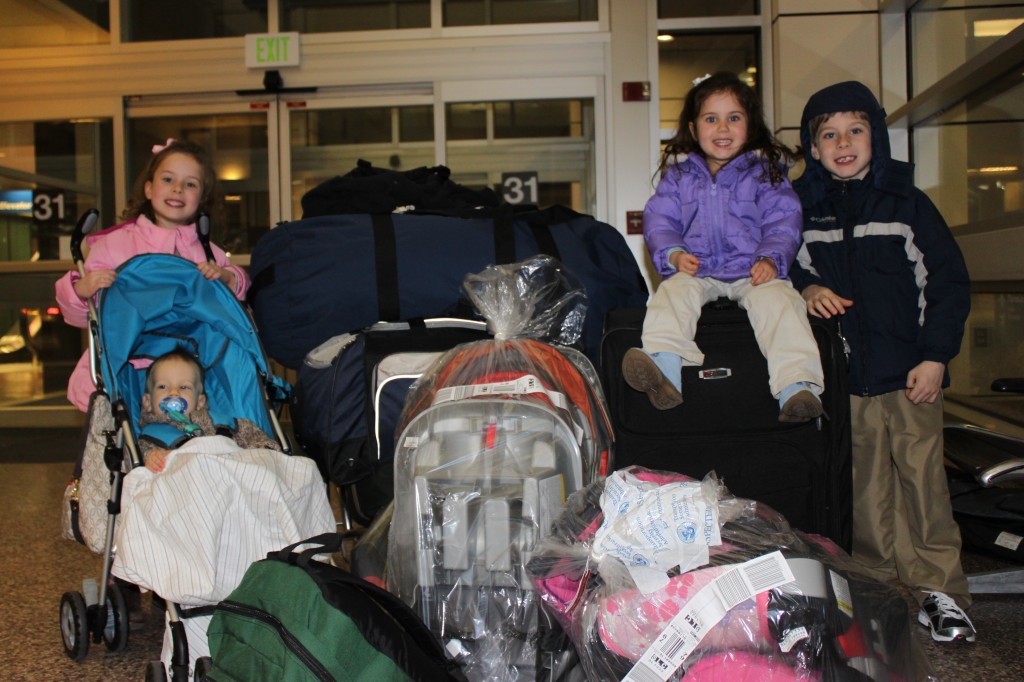Planning for Healthy Sleep While Traveling…Is it Even Possible?

It’s that time of year again…extended family eagerly awaits our arrival, suitcases are filled and the adventure begins. Travel can be fun, but it can also carry anxiety and stress when we consider the effect it might have on our children. The toughest part may be knowing that our kids are currently in a good pattern – sleeping well, free of illness, eating like champs…and we worry the changes that come along with traveling will throw them off and cause major disruption. Below I’ve provided some useful tips to help you avoid the pitfalls that can cause bad habits, sleep deprivation and moody kids (and parents) while you’re away.
In the 2 weeks leading up to the day of travel, make it a point to get him caught up on any sleep debt he may have. Work your days and evenings around making sure he’s very well-rested so that the travel doesn’t have a huge impact on him in regards to how his body handles stress, the onset of possible illnesses, etc.
On the day of travel, don’t even think about trying to keep him on a schedule. If he sleeps on the plane or in the car, great! If not, don’t sweat it and chalk it up to an “off” day.
When you arrive at your destination, shoot for the sleep period that comes next. For example, if the airplane lands at 4:30pm, it’s past the time where he normally naps. If he normally goes to bed at 7pm, try to get him into bed an hour earlier than that because he didn’t have restorative sleep throughout the travel day. Also, it may take him extra time to wind down in his new surroundings. If you’re traveling to a state/country where there is a time difference, change your watch and your mindset immediately after arriving. In the example above, if you arrive at 4:30 the new time but it’s only 2:30 at home, still push him through until the new 7pm. This will allow him to adjust quickly to the new time since he was already out of whack from not sleeping well during travel. It typically takes 2-3 days for children to become acclimated to a different time zone. One exception to this rule is if it is a very short trip and the time difference is only 1 hour, then it’s best to remain going by “home time”.
If you’re traveling with a toddler or preschooler and beyond, it’s very important that you take the time to give him a tour of his new surroundings. Show him where the toilet is that he’ll use before bed or during the night, along with the nightlight that will guide his way, let him help you get his bed ready and allow him to try it out to make sure it’s cozy, point out the kitchen and where he’ll eat his meals, allow him to give any dogs/cats a pat or a treat, show him where his siblings/parents/grandparents will be sleeping, etc. This will drastically decrease his anxiety and ease him into the transition of sleeping in his new environment.
Keep the sleep environment the same as it is at home – take familiar things with you to re-create the sights/sounds/feels he associates with sleep. Ex. noise maker, black out curtains (trash bags and push pins, towels, etc.), lovey, sheets they’re used to, night light, familiar books, etc. This is important because he has already formed sleep associations to these things – without them, the need to sleep will not translate as it should.
As much as you can in a new place, try your best to keep the bedtime routine exactly the same as it always is at home. Do everything in the same order, tone of voice, etc. Don’t allow the expectations to change because you feel bad for him, or you worry he’s going to feel confused and upset. He KNOWS you feel that way if you let on even the tiniest bit!!! Fake it if you have to, but being confident in his ability to flex and “roll with the punches” even though he’s sleeping in a new place.
He may wake up in the night if he becomes aware of his surroundings in between sleep cycles. In this case, handle it just as you would if you were home. However, if you normally ignore nightwakings, my recommendation is to first go to him and do a quick, reassuring check to remind him you’re close-by and all is well. This should last about 30 seconds and shoudn’t involve picking him up or adding stimulation in any way. After the check, leave and allow him to fall back to sleep.
If you’re sharing a room with him while on you’re away, don’t stress! First, place his Pack & Play or mattress as far away from you as possible (in a large closet with the door cracked is my favorite ☺). If he wakes up in the night or early in the morning, respond how you always do and when you return to bed lay still and ignore him. I know this is difficult to do, but after 2 mornings/nights of this he will give up and realize you’re going to get him out on your terms, not his. We did this with all of our kids and it works every time! This is hilarious, but I actually hide under the covers and watch them on the video monitor so that I can see them but they can’t see me! In all seriousness, sharing rooms is usually an unwelcomed necessity during travel, especially with extended family trips. We always make it a point to share our room with the youngest child and then put the older kids together if needed. The younger they are, the harder time they seem to have getting used to their new surroundings, and I’d rather just worry about one child waking up compared to two or more!
Allowing your little one to cry for a bit to sort things out on his own during the night or in the early morning is perfectly fine, but sometimes this doesn’t gel well with extended family members or friends who may be sharing the space with you. If this is the case, buy everyone in the house earplugs and a noise maker to drown out the sound of your screaming kids….haha ONLY KIDDING!!! (I’ve actually been very tempted to do this on occasion)The hard thing about this dilemma is that by accommodating the needs of everyone else, you may be creating habits that you don’t want to return home with. There has to be a happy medium! Be upfront about this issue with whoever may be within earshot during the night and come up with a solution that works for everyone. This may mean putting a time limit on the crying, or finding another place to sleep that won’t disturb the sensitive sleepers in the group. Be flexible, but don’t jeopardize all of the hard work you’ve done to teach your child how to sleep well. When it’s all said and done, no one will have fun if there’s an overtired child in the mix and a grumpy mama/daddy!
After your child has had a few good nights sleep and at least 2 days of strong naps, it’s ok to push him a bit later if needed for 1 or 2 sleep periods. You’re on vacation after all, and you need to have some freedom to do things that may not fit into the confines of his typical schedule. Dinners that run later than usual, sight-seeing, stroller naps, etc. are all part of traveling – and that’s ok! Just make sure you compensate with early bedtimes as often as possible and good, solid sleep days mixed in with the “off”days.
The most important thing about traveling with kids while protecting their sleep, is to be consistent in your approach to the bedtime/naptime routine as well as the way you respond to night wakings and early rising. When you get back home, you don’t want to be forced to re-train your child as a result of bad habits that have formed on the trip. Instead, if you stay consistent (as best you can) regardless of the circumstances ,you’ll just be continuing on with how things always are without leaving room for confusion or back sliding.
Above all, have FUN and RELAX! Your child will sleep better and be in a happier frame of mind based on your attitude. Enjoy your time away from home and create lasting memories with the people you love. Happy traveling!
~ Laura

